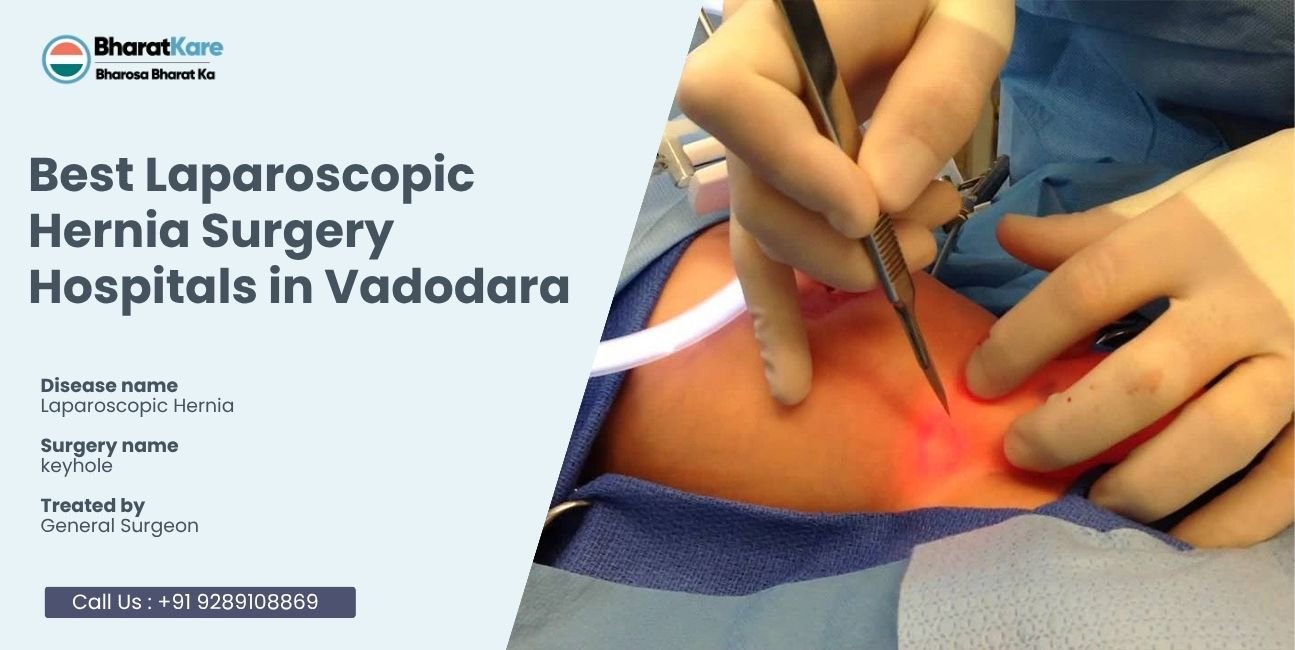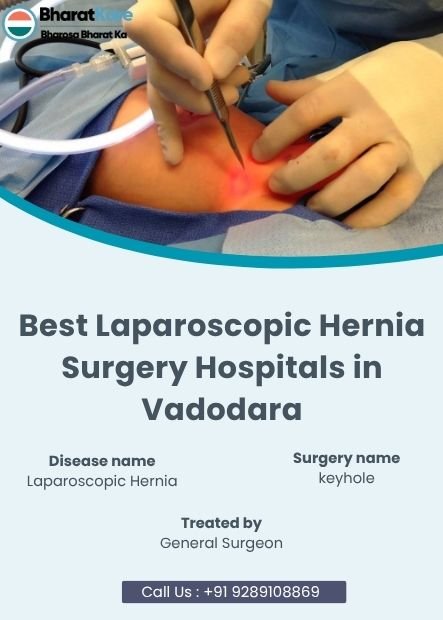Best Laparoscopic Hernia Surgery Hospitals in Vadodara
So, you’ve got a hernia. And you’re probably sitting there googling everything about surgery, right? I get it – that little bulge isn’t going anywhere on its own, and the thought of going under the knife is pretty scary.
Here’s the thing though – hernia surgery has come a really long way. Like, really far. My neighbor just had his done last month using the laparoscopic method, and honestly? He was back to playing cricket within three weeks. Three weeks! His dad had the same surgery twenty years ago and was laid up for two months.
If you’re hunting for the best laparoscopic hernia surgery hospitals in Vadodara, you’re already on the right track. The keyhole surgery approach – that’s what laparoscopic means, basically – is a game changer. But here’s what nobody tells you upfront: not every hospital that claims to do “minimally invasive hernia surgery” actually does it well.
I’ve been around healthcare long enough to know that finding the right hernia treatment center isn’t just about fancy websites or the biggest ads. It’s about actual results, real expertise, and whether they’ll treat you like a person instead of just another case number. Places like Bharatkare have built their reputation on getting this balance right – combining serious surgical skill with the kind of care that makes you feel confident about your decision.
Let me walk you through what you actually need to know about hernia repair surgery. No medical jargon, no sugar-coating. Just the straight truth about getting your hernia fixed properly.


What’s This Laparoscopic Hernia Surgery All About?
Okay, picture this. Your grandfather’s hernia surgery probably involved a cut that looked like he’d been in a sword fight. Big incision, lots of pain, weeks of recovery. That’s the old way.
Repairing a hernia with laparoscopic surgery? Instead of opening a big door to get into a room, you have to squeeze through three small windows. The laparoscope is a camera that the surgeon uses to make small cuts and fix things from the inside with long, thin tools.
The mesh – yeah, there’s usually a mesh involved – gets placed behind your muscle wall instead of on top. Turns out this actually works better than the old method. Who knew?
What does this mean for you practically? Well, most people go home the same day. You’re not flat on your back for weeks. And that constant worry about “what if it comes back” is way less likely because the repair is actually stronger.
My friend’s wife was terrified about the surgery. She kept putting it off, kept making excuses. Finally did it laparoscopically last year and called me two weeks later laughing because she’d been so worried for nothing. She was already back to her yoga classes.
How Do You Pick a Good Hernia Surgery Hospital?
This is where things get tricky. Every hospital website makes them sound amazing, right? “State-of-the-art this” and “world-class that.” But when you’re the one on the operating table, what actually matters for hernia surgery cost and outcomes?
First thing – volume. How many of these laparoscopic procedures do they actually do? A hospital that does five laparoscopic hernia repairs a month versus one that does fifty? There’s going to be a difference in how smooth everything runs. The nurses know what to expect, the anesthesiologist knows the drill, even the person wheeling you to recovery has done this dance before.
Then there’s the equipment situation. I’m not saying you need the absolute latest gadget, but you want HD cameras, good lighting, backup systems. Surgery isn’t the time to be dealing with fuzzy video or equipment that keeps glitching.
But honestly? The hernia surgeon matters most. And not just any surgeon – one who’s been doing laparoscopic repairs for years, not someone who just took a weekend course and decided to give it a try.
You might be surprised at how many places do laparoscopic surgery, but the surgeon has only done twenty of them. That’s not enough for hernia cases that are really hard. You want someone who has done hundreds or even thousands of them. Someone who can deal with things when they don’t go as planned.
Don’t ignore the discomfort—consult a Laparoscopic Hernia Surgery Hospitals. Book your appointment today!
What Makes Some Hospitals Stand Out?
I’ll tell you what I’ve noticed after years of seeing patients go through this process. The really good hospitals don’t just fix your hernia – they walk you through the whole thing.
Like, they actually explain what’s going to happen. Not just “we’ll fix it and you’ll feel better,” but the real details. What the surgery looks like, what you’ll feel like afterward, when you can shower, when you can drive, all that practical stuff you’re actually wondering about.
The best places also have their pre-surgery routine down pat. They’ll check your heart, make sure your medications won’t interfere, sometimes even talk about what you should eat beforehand to heal better. This comprehensive approach to hernia treatment really matters for surgical outcomes. Sounds basic, but you’d be amazed how many hospitals skip these steps.
And here’s something most people don’t think about – what happens when you go home? Good hospitals give you a real plan. Not just “take these pills and call if you have problems,” but actual guidance about recovery.
The Technology Side of Things
Okay, I promise not to get too technical here, but there are some things worth knowing about the equipment side.
Modern laparoscopic surgery uses cameras that are seriously impressive. We’re talking high-definition, sometimes even 3D views. For a surgeon, this means they can see exactly what they’re doing instead of working blind through a big incision.
Some hospitals have upgraded to what they call “smart” surgical systems. These give surgeons better control over their instruments and can even help prevent mistakes. It’s not like the robot is doing the surgery – the surgeon is still in complete control – but the technology makes everything more precise for abdominal wall repair.
Bharatkare has invested pretty heavily in this kind of advanced laparoscopic equipment. They’ve got the HD systems, the smart instruments, all of it. But what I like about their approach is they don’t just buy fancy gadgets – they make sure their surgeons are actually trained to use them properly for inguinal hernia and ventral hernia repairs.
The mesh options have gotten better too. Different types for different situations. A good hospital stocks multiple surgical mesh options because not every hernia is the same, and your surgeon should be able to choose what works best for your specific case.
Recovery – What It’s Really Like
Let me give you the real story about recovery, because a lot of what you read online is either too scary or too rosy.
- The day of surgery: You might feel pretty good, actually. These days, the anesthesia isn’t as bad as it used to be, and the cuts are small, so you don’t have to deal with a lot of pain from surgery. Most people say it hurts like they did too many crunches.
- First few days: This is usually the worst part, but “uncomfortable” doesn’t mean “unbearable.” It helps to walk, which is strange, but it does. Most people can handle stairs, cook their own meals, and that sort of thing.
- Week two: This is where you start seeing why people love laparoscopic surgery. You’re probably back to most normal activities. Still can’t lift heavy stuff, but you can drive, work at a desk, do light housework.
- Month one and beyond: Most people even forget that they had surgery because the mesh has settled in; really, it feels all too normal, and they’re back to whatever they were doing before the hernia showed up.
Now, I shouldn’t say it’s all sunshine and rainbows. Some have more discomfort than others. Some take more time to bounce back. But when you put that aside and compare it to a traditional surgery? Oh, no.
Local Expertise You Can Trust
In Vadodara, you’ve got access to Dr. Ashish Sachdeva, who’s been doing this for twenty years. Twenty years of laparoscopic and bariatric surgery – that’s not someone who’s figuring it out as he goes.
What I respect about Dr. Sachdeva’s approach is that he doesn’t push surgery on everyone who walks through the door. He’ll tell you honestly if laparoscopic repair is right for your situation or if you might be better off with a different approach. That kind of honesty is rare.
The Bharatkare facility in Vadodara has built a solid reputation for thorough consultations. They don’t rush you through a fifteen-minute appointment and hand you a surgery date. They take time to explain your options, answer your questions, even help you understand what your insurance will cover.
What You’re Comparing | Traditional Surgery | Laparoscopic Surgery |
Size of cuts | One big cut (4-6 inches) | Three tiny cuts (half inch each) |
Going home | 2-3 days in hospital | Same day or overnight |
Back to work | 4-6 weeks | 1-2 weeks |
Pain level | Pretty rough | Much more manageable |
Scars | One big obvious scar | Three tiny marks |
Chance it comes back | Higher risk | Lower risk |
Don’t ignore the discomfort—consult a Laparoscopic Hernia Surgery Hospitals. Book your appointment today!
Is Laparoscopic Right for Everyone?
Here’s where I have to be straight with you – it’s not automatic that laparoscopic is the best choice for your specific hernia.
Really big hernias sometimes need the open approach. If you’ve got a hernia that’s been there for years and has gotten pretty large, the surgeon might need that bigger incision to put everything back where it belongs properly.
Previous surgeries can complicate things too. If you’ve had other abdominal operations, there might be scar tissue that makes the laparoscopic approach trickier. Not impossible, but something an experienced surgeon needs to factor in.
Your overall health matters too. The laparoscopic technique requires some gas to be pumped into the abdomen, thus giving the surgeon some space to work. It is no big deal for most people. But if you have certain heart or lung problems, it might not be the safest option for you.
And that is why a good consultation is so important. The surgeon involved should be experienced, be able to look at your particular situation, and then sincerely advice you on which route makes the most sense.
The Money Talk
Let’s be real about costs because this is probably on your mind. Laparoscopic surgery can cost a bit more than traditional repair upfront. But when you factor in everything else? It often works out about the same or even cheaper.
Consider it: irregular working possibilities, with any claim on payment, go by week. A series of four weeks of down time means the loss of four weeks of payment from income. Four weeks less of pain medication is saving another pile of dollars. Four weeks fewer follow-ups saves even more while a few of these appointed visits require others of personal assistance for housework and follow-ups, therefore, cutting costs or cutting working hours for the family.
The insurance providers usually cover laparoscopic hernia repair when medically indicated. The key is to collaborate with a hospital that’s well versed in dealing with insurance companies and is able to offer you a realistic cost estimate upfront.
Questions You Should Actually Ask
When you’re talking to surgeons, don’t be shy about asking direct questions. Good surgeons want informed patients, not people who just nod and say “whatever you think is best.”
Ask how many laparoscopic hernia repairs they do in a typical month. If the number is small, that should make you pause. Ask about their complication rate – everyone has complications sometimes, but you want someone who’s honest about their track record.
Find out what type of mesh they prefer and why. There are different materials, different techniques for placing them. A surgeon should be able to explain their approach in terms you can understand.
Talk about recovery expectations specifically. Not just “you’ll be fine in a few weeks,” but realistic timelines about when you can drive, when you can lift your kids, when you can go back to the gym.
Support Beyond Surgery
Something that separates the really good hospitals from the average ones is what happens after you leave the operating room.
The best places have nurses who specialize in post-surgical care and actually know what they’re talking about when you call with questions. They have systems for checking on you during recovery, not just “call us if something goes wrong.”
Bharatkare’s approach includes detailed discharge instructions that actually make sense, follow-up appointments that aren’t rushed, and access to their medical team when you have concerns during recovery. It sounds basic, but you’d be surprised how many places fall short on this stuff.
They also provide realistic expectations about recovery. Not scary worst-case scenarios, but honest information about what’s normal and what should concern you.
What to Watch Out For
There are some red flags which should make you seriously reconsider your hospital or surgeon of choice.
- Be wary of anyone who pushes you to go in for surgery today and leaving you no time to think or gather a second opinion. Hernia surgery is rarely an emergency; you should get to make a well-informed decision.
- If he or she can’t or doesn’t want to answer your questions about their experience or complication rate, that’s a red flag. Transparency should be a given, not something you need to argue for.
- Issues arise when they’re placing unreasonable timelines on recovery. Anyone who says you’ll be “completely back to normal in a few days” is either lying or hasn’t got a clue what they’re talking about.
Real Talk About Complications
Let’s put this issue into perspective. You are scared, I know. Yes, complications can occur with any surgical procedure, including laparoscopic hernia repair. Not so often, though, especially in an experienced surgeon’s hands.
Infrequently, one has minor issues: a little swelling, some numbness around the incision sites making it feel funny for days or weeks, nausea here and there from the anaesthesia. Rarely do serious complications like infection or mesh problems occur, especially within well-run facilities.
If you have surgeons with good experience at hand, they will have a backup plan. In case anything unexpected arises during laparoscopic surgery and it would be safer to go with an open approach, the surgeon will do exactly that. This is not a failure; this is in less than 5% of cases safety mechanism.
Making Your Decision
Ultimately, you must be at ease with your decision. Though fear can prevent you from receiving necessary care, don’t let anyone pressure you into making a choice.
Take time to research your options. Meet with surgeons. Ask all your questions. Trust your gut about whether the medical team feels like they’re really listening to your concerns.
The best laparoscopic hernia surgery hospitals in Vadodara combine technical skill with genuine patient care. They have experienced surgeons, proper equipment, and support systems that work. Places like Bharatkare have earned their reputation by consistently delivering this combination.
Your hernia isn’t going to get better on its own. But with the right surgical team, you can look forward to getting back to your normal life faster than you probably think possible.
The Bottom Line
Hernia surgery doesn’t have to be the ordeal it used to be. Laparoscopic techniques have genuinely transformed the experience for most patients – less pain, faster recovery, better long-term results.
But success depends on choosing the right place and the right surgeon. Don’t just go with whoever is closest or cheapest. Do your homework. Ask questions. Make sure you feel confident in your choice.
The investment in quality care now can give you years of comfort and peace of mind. And honestly? Most people wish they hadn’t waited so long once they experience how much better they feel after proper treatment.
That neighbor I mentioned earlier? He keeps telling everyone he knows with a hernia to stop putting it off. “I wasted two years worrying about surgery that took less time than getting my car serviced,” he says. “And now I feel better than I have in years.”
Your situation might be different, but the principle remains the same. With the right medical team and the right approach, you can get back to living your life without that constant reminder that something isn’t quite right
FAQ
FAQs About Laparoscopic Hernia Surgery Hospitals: Answering Your Most Common Queries
Most hernias do get bigger over time, though how fast varies from person to person. The real worry isn't just size - it's the risk of the hernia getting "stuck" (incarcerated) or having its blood supply cut off (strangulated). Both are surgical emergencies. While not every hernia needs immediate surgery, most will eventually need repair.
Most inguinal hernias (the common groin ones) and many ventral hernias are good candidates for laparoscopic repair. But hernia size, location, your previous surgical history, and overall health all factor in. The only way to know for sure is a thorough evaluation with an experienced surgeon.
Experienced surgeons always have contingency plans. If the laparoscopic approach isn't working well - maybe due to scar tissue or anatomy that's more complex than expected - they can convert to open surgery. This happens in less than 5% of cases and isn't considered a complication. It's a safety measure.
Age alone doesn't rule out laparoscopic repair. In fact, the faster recovery often makes it preferable for older patients. However, heart and lung function, overall health, and ability to handle general anesthesia are all important considerations that need individual evaluation.
Quick Links
Popular Surgeries
Find Us
© Copyright BharatKare 2025. All Right Reserved.


